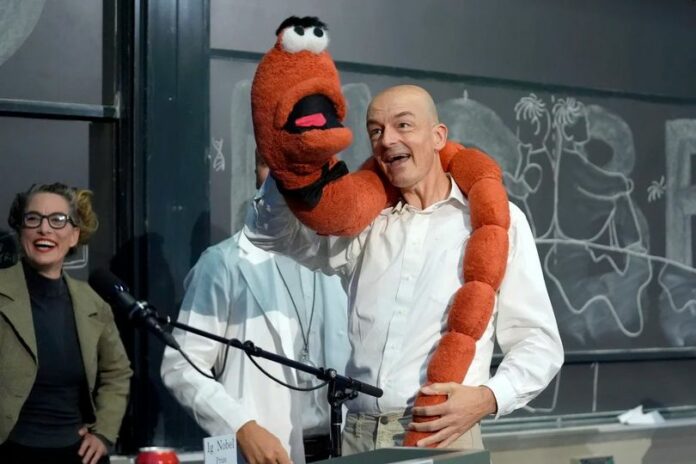
:SANDER WOUTERSEN: The Dutch scientist accepts his Ig Nobel award, accompanied by a sober worm
Photo credit: FB/PH Chemistry
Dutch scientists have won Ig Nobel prizes for the fifth year running.
The award for the Probability Category went to Professor Eric-Jan Wagenmakers from Amsterdam University and a team of international scientists for providing proof that the side of a coin that is face-up before it is tossed generally lands face-up.
Researchers, again from Amsterdam University, who were led by physical-chemist Sander Woutersen and physicist Daniel Bonn were rewarded for their work on racing drunk and sober worms to gain more understanding of polymer dynamics through analysing the differences in wriggle activity
The satirical Ig Nobel prizes have been organised by the humorous scientific magazine, Annals of Improbable Research (AIR), since 1991 to celebrate 10 “unusual or trivial” achievements in scientific research.
They are presented by the Massachusetts Institute of Technology in Cambridge (Massachusetts) and their aim is to make people laugh “and then think, AIR said.
The 48 members of Wagenmakers’ team took 650 hours to flip a coin 350,757 times to conclude that 51 per cent of the time it fell with the same face still on top.
This was the first time that the “heads or tails” phenomenon had been looked at in depth, the professor said, before adding that it was unclear whether the findings would influence a referee’s toss-up at the start of a game.
Wagenmakers added that the result is influenced by the movement of the throw. “When we flip a coin we do a bit of a wobble. That ensures the coin is airborne just that little longer,” he told the Parool newspaper after reporting the team’s findings last year.
In his Ig Nobel acceptance speech on September 12, the scientist urged everyone to try replicating the experiment.
On collecting their chemistry prize, Sander Woutersen and Daniel Bonn gave a live demonstration of their use of chromotagraphy to separate drunk and sober worms.
“We’re very excited. We’ve had a hard time shutting up about it,” said Bonn who in the past has reported on why quicksand never completely submerges a victim.
This time the team intoxicated worms by temporarily placing them into a three to five per cent ethanol solution and dying them blue.
They were placed with the sober red-coloured worms in a maze of miniature pillars with distilled water flowing along its length, and measured the time the worms spent there.
Woutersen said they had expected the inebriated worms to exit the maze faster, assuming they would “go with the flow” while the active worms would get stuck. Instead the drunken worms exhibited less activity and sober worms tended to curl and knot.
“The sad conclusion is that the drunk worms get home very late,” Woutersen.
Like all Ig Nobel prizewinners, the two Dutch teams will each receive of 100 trillion Zimbabwean dollars (available for $22 on eBay) plus a box containing items relating to “Murphy’s Law”, the theme of this year’s ceremony.
Unsurprisingly, some items were missing, the Ig Nobel presenters warned, and the box itself was “almost impossible to open.”


